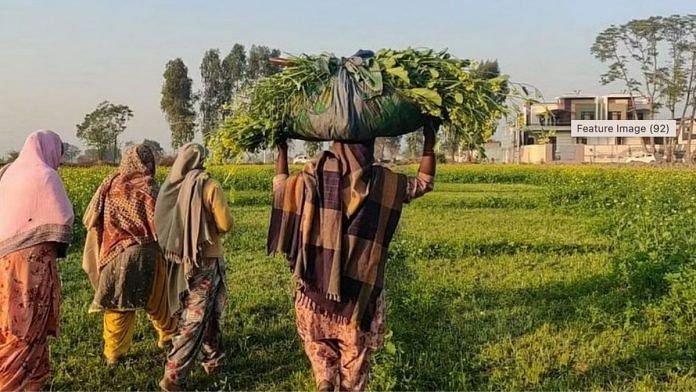Thank you dear subscribers, we are overwhelmed with your response.
Your Turn is a unique section from ThePrint featuring points of view from its subscribers. If you are a subscriber, have a point of view, please send it to us. If not, do subscribe here: https://englishdev.theprint.in/subscribe/
Given that growth in the agriculture sector is expected to slow to 1.8% in 2023–24 from 4% a year ago, the government is expected to considerably increase agricultural sector funding in the upcoming interim budget 2024-25 to support the rural economy. Many Economists believe that the reduction in budget allocation was responsible for reporting negligible growth in the agricultural sector in 2023-24. The budget allocation for agriculture sectors has declined from ₹ 1.33 lakh crore (2022-23) to ₹ 1.25 lakh crore in 2023-24. The agricultural sector accounted for only 3.78% of the total budget share in 2021-22; it went down to 3.36% in 2022-23 and then drastically declined to 2.78% in the last UB. (Budget at a Glance 2023-2024).
The inadequate rainfall and withdrawal of the three farm laws have also adversely impacted the sectors by not allowing them to introduce Contract farming in all the states to boost productivity and bring major reform in agricultural marketing. We have huge expectations from the upcoming interim Budget 2024-25 for the agricultural sectors to boost farm productivity and double the farmers’ income. The finance minister will likely increase the allocation for the following sectors to bring the agricultural sectors on the growth track.
Increase in the allocation for the Institutional credit:
The financing minister will likely increase the budget allocation for agricultural credit targets to 22-25 lakh crore in the upcoming UB 2024-25 from 20 lakhs core in UB 2023-24. Until December 2023, around 82 % of the Agri. A credit target of 20 Lakh crore has been achieved. Situation Assessment of Agricultural Households and Land and Livestock Holdings of Households 2019 report (NSS) shows that around 50.2 % of agricultural households are indebted, and 69.9 % of the farmers borrowed their loans from the Institutional source.
Increase in the allocation for MGNERGA:
Among all the schemes, MGNERGS has seen the most significant decline by Rs 13,000 crore (17.8% reduction in the UB 2023-24 as compared with 2022-23), followed by PM-Kisan grant by Rs 8,000 crore (17.8% reduction). However, considering the upcoming election, the government is likely to increase the expenditure for MGNERGE to reduce unemployment and poverty. Agricultural labour have faced many challenges in getting jobs in rural areas; hence, we expect to revert the allocation under MGNREGA to provide unemployment. The government is likely to increase funds for female farmers to empower them.
Market-Driven Reform:
The forthcoming budget allows the government to increase capital allocation to promote market-driven reform. The government launched an agriculture infrastructure fund in 2020 to develop post-harvest infrastructure, but only 15 percent of the amount has been disbursed in the last three years. After withdrawing the three farm laws in 2021, we are expecting the government to emphasize promoting the electronic national agriculture market (e-NAM) in UB 24-25 by extending the online trading platform in other regulated APMC markets. Around 1389 regulated mandis in 23 states and 4 Union Territories are linked with e-NAM in 2023. The electric market would help the farmers to overcome the asymmetric information problem while selling their fruits and vegetables.
Promotion of FPO:
A budgeted allocation of Rs 6,865 crore was made by the Indian government in 2020 for the formation and promotion of 10,000 new FPOs by 2024. The program was designed to give farmers more negotiating power, take advantage of economies of scale, and raise their profits by grouping their agricultural output. November 30, 2023, approximately 7,597 FPOs had been registered in India under the scheme. The government is likely to increase the allocation for the FPO to boost smallholders’ income.
Increase in the use of artificial intelligence (AI):
We expect the government to increase allocation to promote artificial intelligence (AI) uses to increase productivity. India is the second largest producer of paddy and Wheat behind China. India has reported only 4.1 tons per hectare yield for Paddy compared to 7.0 tons per hectare for China in 2021-22. Similarly, for wheat, India accounted 3.4 tons per hectare yield as compared with 5.7 per hectare for China for the same time. Therefore, there is an urgent need to increase the allocation of capital and infrastructure to overcome the gap in yield.
The policymakers strongly believe that the Finance Minister should prioritize the agriculture sectors to boost the rural economy, which was neglected in UB 2023-24. We can encourage higher demand in rural areas by improving the employment environment and increasing government expenditure. By allocating more funding for rural infrastructure development, we could achieve the Prime Minister’s dream of achieving a $ 7 trillion economy by 2023.
Dr. Kedar Vishnu, Assistant Professor of Economics, Narsee Monjee Institute of Management Studies (NMIMS)
Vidhi Gera, BSc Economics Student at CHRIST (Deemed to be University), Pune.
These pieces are being published as they have been received – they have not been edited/fact-checked by ThePrint.


